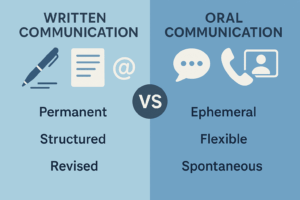Written vs. Oral Communication: What’s the Difference?
Communication is central for allied health services. It is clearly important for speech and language pathologists, but communication skills are also important for occupational therapists, physiotherapists, psychologists, and many more. How these allied health professionals communicate and share information can make a real difference to services and outcomes. This includes talking in-person, on the phone, or during online telepractice appointments, as well as writing like emails, letters, and reports.

So let’s pause to think about how written and oral communication differ, and why it matters.
What is Oral Communication?
Oral communication happens when we talk with other people: conversations, phone calls, team meetings, and informal chats.
In allied health services, oral communication is used to do things like:
- Describe outcomes of assessments
- Explain reasons for things like recommendations
- Talk about health decisions
- Supervision discussions
- Build relationships and trust
Some key features of oral communication
Immediate: Happens in ‘real time’ with little time to plan.
Interactive: Able to have clarification, questions, and feedback.
Flexible: Adaptable to listener’s needs and respond to reactions.
Ephemeral: Unless it is recorded, it disappears after it’s said.
What is Written Communication?
Written communication includes information that is typed or transcribed on paper or electronic form using language (i.e., words and/or sentences)
Examples of written communication in allied health include reports, notes, care plans, emails, and even text messages.
In allied health, written communication is often used to:
- Document assessments and interventions
- Share information with a client, a family, or other professionals
- Provide recommendations or instructions to clients and carers
Some key features of written communication:

Permanent: Once written, it can be referred to many times.
Structured: Usually follows an intuitive flow, format, or template.
Carefully crafted: There’s time to think, edit, and clarify.
Accessible: Can be shared with many people over time.
Why Does the Difference Matter?
Written communication:
- can be reviewed multiple times but may be harder to understand if it’s not written well, needs a lot of background knowledge, or has lots of jargon.
- can be a barrier for people with low literacy or vision impairments.
- are essential for legal documentation and continuity of care.
Oral communication:
- allows for immediate clarification, but people may forget details or misunderstand.
- can be challenging for people with hearing or communication disabilities.
- is less formal but crucial for building relationships and teamwork.
Both written and oral communication are vital in allied health. Understanding the strengths and limitations of both can help us all connect better and ultimately, provide safer, more effective services.

Tips for Effective Communication in Allied Health
Be clear and concise: Whether writing or speaking, avoid jargon and explain terms.
Check understanding: Ask questions or invite feedback to make sure your message is understood.
Adapt to your audience: Consider the person’s communication needs and preferences.
Acknowledgement: Written with AI support